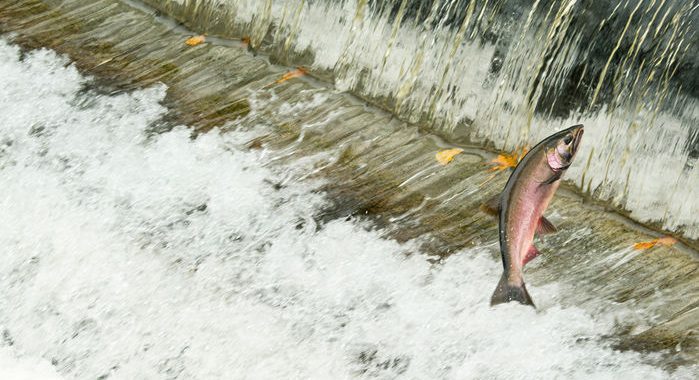
Coho Salmon, jumping over dam, Issaquah Creek, October, Isaaquah, Washington USA
For decades, something in urban streams has been killing coho salmon in the U.S. Pacific Northwest. Even after Seattle began to restore salmon habitat in the 1990s, up to 90% of the adults migrating up certain streams to spawn would suddenly die after rainstorms. Researchers suspected the killer was washing off nearby roads, but couldn’t identify it. “This was a serious mystery,” says Edward Kolodziej, an environmental engineer at the University of Washington’s (UW’s) Tacoma and Seattle campuses.
Online today in Science, researchers led by Kolodziej report the primary culprit comes from a chemical widely used to protect tires from ozone, a reactive atmospheric gas. The toxicant, called 6PPD-quinone, leaches out of the particles that tires shed onto pavement. Even small doses killed coho salmon in the lab. “It’s a brilliant piece of work,” says Miriam Diamond, an environmental chemist at the University of Toronto. “They’ve done a tremendous job at sleuthing out a very challenging problem.”
Manufacturers annually produce some 3.1 billion tires worldwide. Tire rubber is a complex mixture of chemicals, and companies closely guard their formulations. Because tire particles are a common component of water pollution, researchers have been examining how they affect aquatic life.
Read our COVID-19 research and news.

Particles that erode from tires wash into streams used by coho salmon.
KEVIN SCHAFER/GETTY IMAGES
Common tire chemical implicated in mysterious deaths of at-risk salmon
For decades, something in urban streams has been killing coho salmon in the U.S. Pacific Northwest. Even after Seattle began to restore salmon habitat in the 1990s, up to 90% of the adults migrating up certain streams to spawn would suddenly die after rainstorms. Researchers suspected the killer was washing off nearby roads, but couldn’t identify it. “This was a serious mystery,” says Edward Kolodziej, an environmental engineer at the University of Washington’s (UW’s) Tacoma and Seattle campuses.
Online today in Science, researchers led by Kolodziej report the primary culprit comes from a chemical widely used to protect tires from ozone, a reactive atmospheric gas. The toxicant, called 6PPD-quinone, leaches out of the particles that tires shed onto pavement. Even small doses killed coho salmon in the lab. “It’s a brilliant piece of work,” says Miriam Diamond, an environmental chemist at the University of Toronto. “They’ve done a tremendous job at sleuthing out a very challenging problem.”
Manufacturers annually produce some 3.1 billion tires worldwide. Tire rubber is a complex mixture of chemicals, and companies closely guard their formulations. Because tire particles are a common component of water pollution, researchers have been examining how they affect aquatic life.
After Kolodziej arrived at UW’s Center for Urban Waters in 2014, he joined the effort to solve the coho salmon mystery. The group created a mixture of particles from nine tires—some bought new, others provided by two undergraduates who moonlight as mechanics—to mimic what might wash off typical highways. They found several thousand unidentified chemicals in the mixture. Postdoc Zhenyu Tian spent more than 2 years narrowing down the list, separating the molecules based on their electrical charge and other properties. By May 2019, he had narrowed the focus to about 50 unknown chemicals, and then further work revealed the chemical formula of a prime suspect. “If you’re looking for an unexplained toxicant that’s killing fish, we had the perfect instruments and expertise,” Kolodziej recalls.
But what was it? A 2019 report from the Environmental Protection Agency on chemicals in recycled tires mentioned 6PPD, which has a similar formula. The final clue was buried in an industry report from 1983, which contained the exact formula of 6PPD-quinone, the molecule created when 6PPD reacts with ozone. The team synthesized 6PPD-quinone and found it was highly lethal to coho salmon.
Now, the team is working to understand how the chemical kills fish. Kolodziej and colleagues say other species of fish should also be evaluated for sensitivity. Because you can’t buy the molecule, Kolodziej’s team is making it. “My lab might even be the only place that actually has this,” he says.
The researchers suspect the compound is present on busy roads everywhere. They’ve found it washes off pavement and into streams in Los Angeles and San Francisco, for example. The simplest solution might be for tire manufacturers to switch to an environmentally benign alternative. But Sarah Amick, vice president of environment, health, safety, and sustainability at the U.S. Tire Manufacturers Association, says it’s too early to discuss alternatives. “It’s important that additional research be done to validate and verify these results.”
Another way to protect salmon is to filter stormwater through soil, but installing enough infiltration basins to treat road runoff before it reaches spawning streams would be very expensive, says co-author Jenifer McIntyre, an ecotoxicologist at Washington State University’s Puyallup Research and Extension Center. In the meantime, Kolodziej says he “can’t walk along a street without staring at all the skid marks,” thinking about tire chemicals, and “wondering what’s there.”

